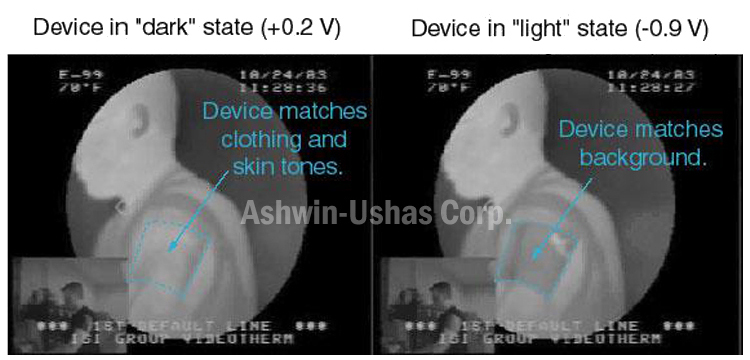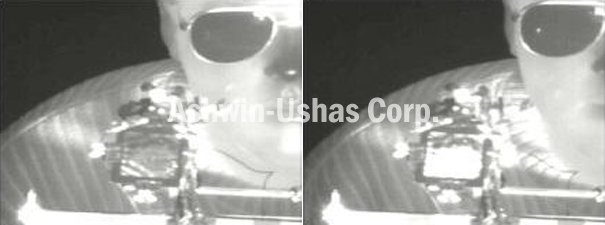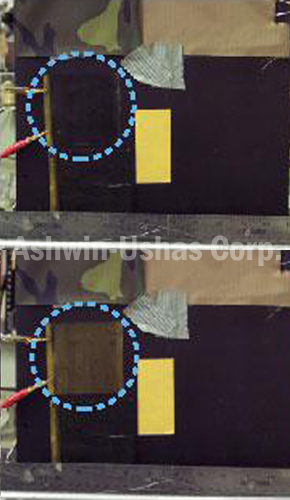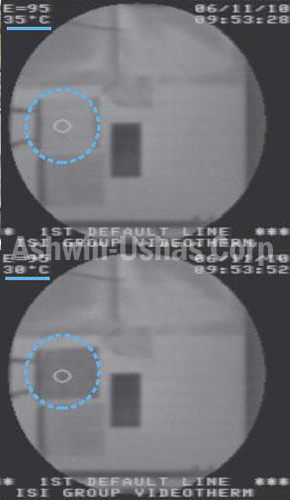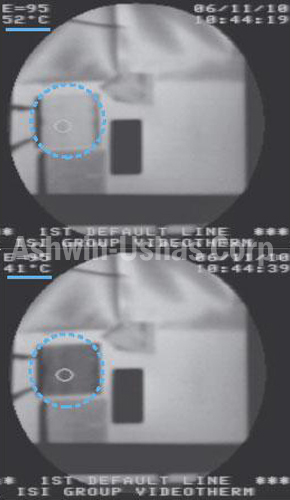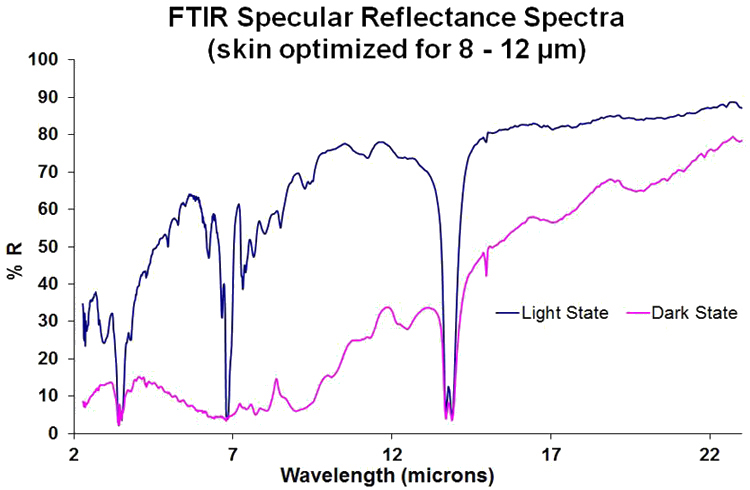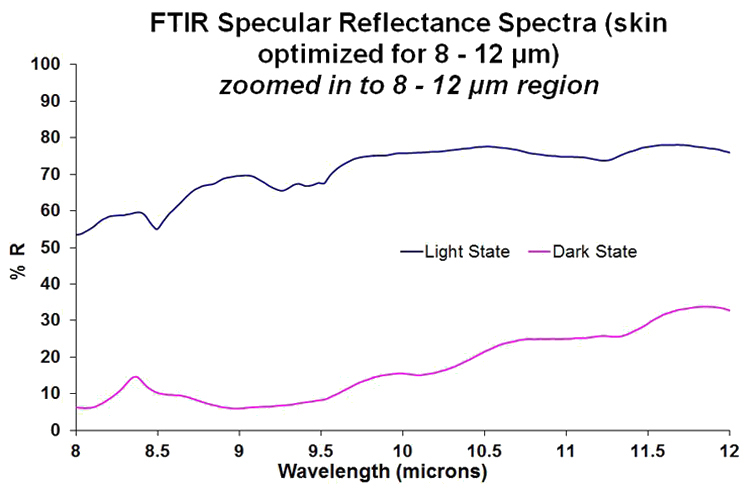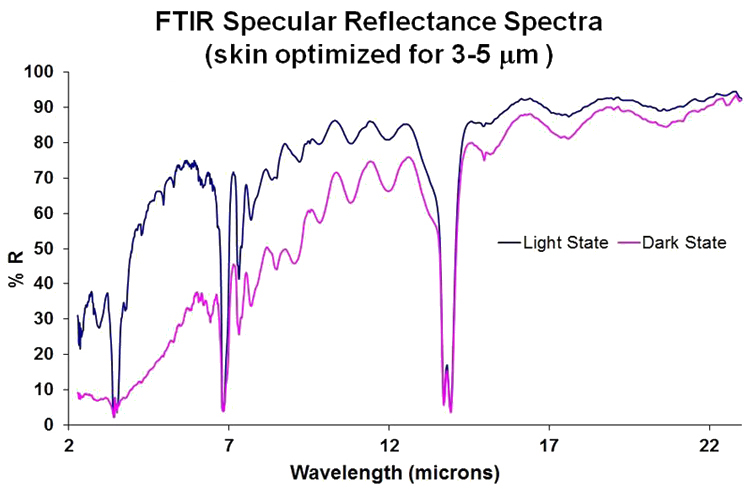World Leader In IR-electrochromic Materials and the Related Variable Emittance Materials
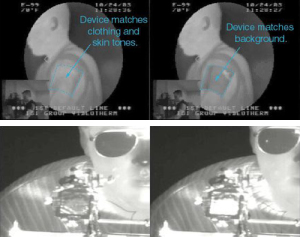 Camouflage via chameleon-like matching with the background, not in the Visible spectral region that the human eye sees in, but rather in the mid- and long-wave infrared region (MWIR, LWIR, 3 to 12 microns). Yields an overwhelming advantage in night operations. A complete camouflage countermeasure against IR cameras operating in these spectral regions. (These IR cameras are not night-vision cameras, which operate in the near-IR to about 2 microns and need some ambient light to work- they don’t work on moonless nights.)
Camouflage via chameleon-like matching with the background, not in the Visible spectral region that the human eye sees in, but rather in the mid- and long-wave infrared region (MWIR, LWIR, 3 to 12 microns). Yields an overwhelming advantage in night operations. A complete camouflage countermeasure against IR cameras operating in these spectral regions. (These IR cameras are not night-vision cameras, which operate in the near-IR to about 2 microns and need some ambient light to work- they don’t work on moonless nights.)
IR Electrochromic Materials
- IR-electrochromic materials change “color” in the IR, dynamically. This “color” is variable and can be adaptive, i.e. matching the background, much like a chameleon, except in the IR.
- These materials can thus provide camouflage countermeasures, in threat situations, against IR cameras operating in the 3 to 12 μm regions. These cameras are not night-vision devices, which operate in the near-IR (0.9 to 1.5 μm) region and are in reality image-intensifiers which need some, minimal light to operate (they do not work on, e.g., moonless nights). Such adaptive, IR camouflage can give tremendous advantage in night operations.
- Performance can be judged by several parameters, e.g. %-Reflectance (%R) contrast in the IR, apparent temperature variation and emittance (integrated emissivity).
Ashwin’s Technology
- Ashwin’s patented dynamic (switchable) IR-electrochromics technology is based on Conducting Polymer (CP) IR-electrochromics, a unique skin design, and a “smart” Controller for efficient, adaptive camouflage.
- They have low power (+/- 3 VDC, < 50 μW/cm²), extremely low cost.
- The electrochromic skins are thin (< 0.5 mm), flexible, very lightweight (0.12 g/cm² or 1.2 kg/m²), extremely durable, cuttable with scissors to any shape/size/area, affixable to any surface.
- Typical performance:
- 76% (extreme light, low-emissivity state) to 4% (extreme dark, high-emissivity state) at 10 μm (LWIR), as measured by FTIR Specular Reflectance.
- 55% (extreme light state) to 13% (extreme dark state) at 5.5 μm (MWIR), as measured by FTIR Specular Reflectance.
- Values “dialable” to any intermediate values between above light/dark extremes.
- Skins can be optimized for the MWIR, LWIR or both.
- Switching Time, for full switching between extreme light and extreme dark states is < 2 s.
- Matching to all kinds of backgrounds, from cold sky, water and foliage to soil, desert sand and man-made structures like buildings, vehicles and soldier uniforms.
- Demonstrated to have excellent durability against expected environmental conditions, including sand blasts, wind, heavy rain and extreme temperatures (-40 to +80°C).
- Superior in performance as well as cost to competing technologies such as Peltier plates, other electrochromic systems, thermochromic systems.
Learn more…
- IR-ELECTROCHROMIC SKINS PRIMER
- DESCRIPTION OF ASHWIN IR-ELECTROCHROMIC SKINS
- PERFORMANCE
- COMPARISON OF PERFORMANCE AND COST WITH COMPETING TECHNOLOGIES
- DATA: CONSTRUCTION, APPEARANCE
- DATA: TYPICAL PERFORMANCE DATA
- RELEVANT LITERATURE REFERENCES
- AVAILABILITY AND FURTHER INFORMATION
INFRARED (IR)-ELECTROCHROMICS PRIMER
- IR-electrochromic materials change “color” in the IR. This “color” is variable and can be adaptive, i.e. matching the background, much like a chameleon, except in the IR.
- These materials can thus provide camouflage countermeasures, in threat situations, against IR cameras operating in the 3 to 5 μm (mid-wave IR, MWIR) and 8 to 12 μm (long-wave, LWIR) regions. These cameras are not night-vision devices, which operate in the near-IR (0.9 to 1.5 μm) region and are in reality image-intensifiers which need some, minimal light to operate (they do not work on, e.g., moonless nights).
- Such adaptive, IR camouflage can give tremendous advantage in night operations.
- Performance can be judged by several parameters, e.g.:
- IR Reflectance spectra in the two spectral regions of interest (3 to 5 μm (mid-wave IR, MWIR) and 8 to 12 μm (long-wave, LWIR)). Typically, Specular (rather than Diffuse) spectra give the most information. The larger the contrast between light and dark states, the better the performance.
- Apparent temperature, as measured by an IR camera. For best camouflage, the temperature of the IR-electrochromic skin should be as close as possible to that of the background that one is trying to match.
- Emittance (integrated emissivity). See description of Ashwin-Ushas Variable Emittance Skins.
DESCRIPTION OF ASHWIN IR-ELECTROCHROMIC SKINS
- Patented technology based on:
- Conducting Polymer (CP) as the active IR-electrochromic, yielding the variable IR signature.
- Unique design, allowing direct exposure of active IR-electrochromic to external environment and single-microporous-membrane construction.
- Thin (< 0.5 mm), flexible, very lightweight (0.12 g/cm² or 1.2 kg/m²), extremely durable skins, cut with scissors to suit any shape/size and area.
- Can be affixed to any surface.
- Operate with small, applied DC voltage (less than +/- 3 VDC).
- “Smart” Controller for efficient, adaptive camouflage.
- Extremely low cost.
PERFORMANCE
- Typical IR contrast:
- 76% (extreme light, low-emissivity state) to 4% (extreme dark, high-emissivity state) at 10 μm (LWIR), as measured by FTIR Specular Reflectance.
- 55% (extreme light state) to 13% (extreme dark state) at 5.5 μm (MWIR), as measured by FTIR Specular Reflectance.
- Corresponding emittance variations are ca. 0.15 to 0.80.
- Values “dialable” to any intermediate values between above light/dark extremes.
- Skins can be optimized for LWIR, MWIR, or both. Quasi-independent control of IR and Visible signatures.
- Switching Time, for full switching between extreme light and extreme dark states is < 2 s.
- Matching to all kinds of backgrounds, from cold sky, water and foliage to soil, desert sand and man-made structures like buildings, vehicles and soldier uniforms.
- Cyclability: Tested to 10,000 light/dark cycles without significant degradation.
- Demonstrated to have excellent durability against expected environmental conditions, including sand blasts, wind, heavy rain and extreme temperatures (-40 to +80°C).
- Power requirements: +/- 3 VDC, < 50 μW/cm².
- Indefinite shelf life in packaging and at storage temperatures between -20 and +50°C.
COMPARISON OF PERFORMANCE AND COST WITH COMPETING TECHNOLOGIES
- Essentially no competing technology with even comparable performance. Examples of extant, competing technologies:
- Arrays of Peltier plates which are actively, rapidly heated/cooled. These are primarily for countermeasures against night-vision, i.e. near-IR, have very high power requirements and, of course, do not work in the MWIR or LWIR. They are also very expensive and bulky.
- Other electrochromic systems, e.g. those based on poly (2,7 carbazole) derivatives. These have extremely poor IR performance, no match for our systems.
- Thermochromic systems, e.g. those based on, and choleric liquid crystals, or active heating of a metallized plastic surface. These again have extremely poor IR performance, no match for our systems.
- Other variable emittance technologies developed for use in space are not suitable for adaptive, terrestrial IR-camouflage. (See description under Ashwin-Ushas Variable Emittance Skins).
- 1⁄5 to 1⁄10 the cost of other technologies described above (which in any case do not work well in the MWIR and LWIR).
DATA: CONSTRUCTION, APPEARANCE
Click images to enlarge.
LWIR (8 – 12 μm) images with IR-electrochromic skin mounted on Cu plate heated to 66°C:
The tailorable variation of the apparent temperature (i.e. IR signature), as shown, allows matching with different backgrounds.
MWIR (3 – 5 μm) images with IR-electrochromic skin mounted on Al plate cooled from behind to 11°C:
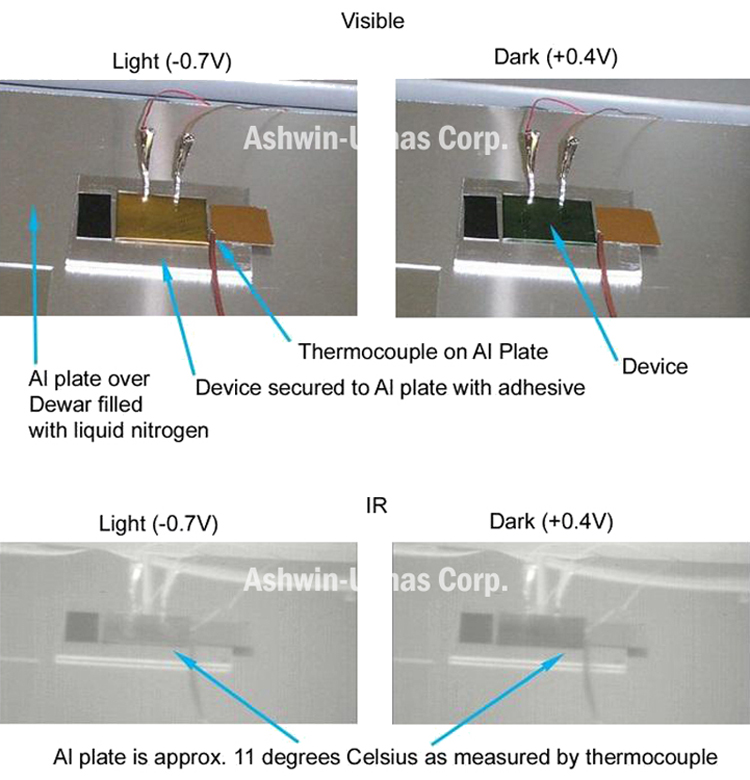
Bottom row: Left and Right, respectively, light (non-emissive) and dark (emissive) state of skin.
Top row: Same, Visible-region photo.
DATA: TYPICAL PERFORMANCE DATA
Click tables and graphs to enlarge.
LWIR (8 – 12 μm) data
MWIR (3 – 5 μm) data
RELEVANT LITERATURE REFERENCES
Our Technology
- Journal of Applied Polymer Science, 2014, 131(19), 40850 (October 2014); DOI: 10.1002/app.40850
- National Aeronautics and Space Administration, NASA Publications (downloadable pdf)
Competing Technology
- Adaptiv, Active Camouflage Technology
- Multicolored Electrochromic Cells Based On Poly(2,7-Carbazole) Derivatives For Adaptive Camouflage
- Thermal/optical Camouflage with Controlled Heat Emission
- Thermal and Visual Camouflage System
- Passive Control of Emissivity, Color and Camouflage
AVAILABILITY AND FURTHER INFORMATION
For inquiries, please Contact Us.
